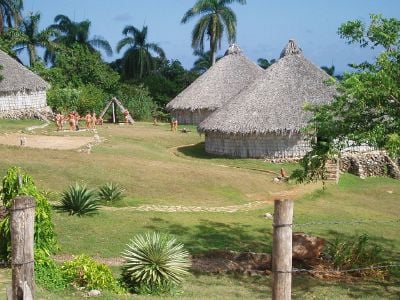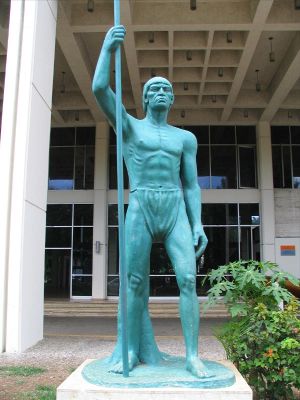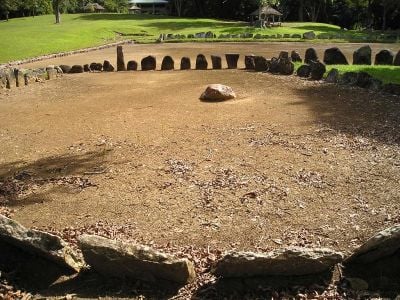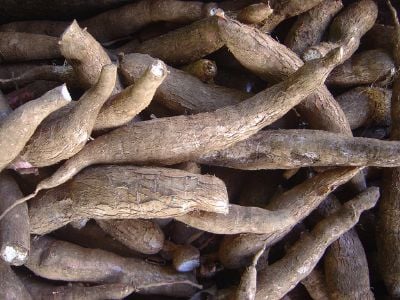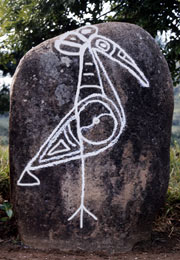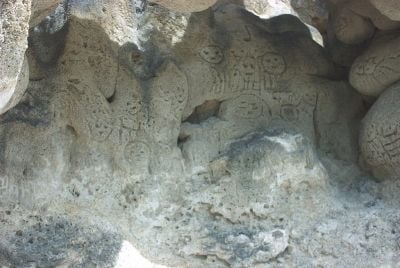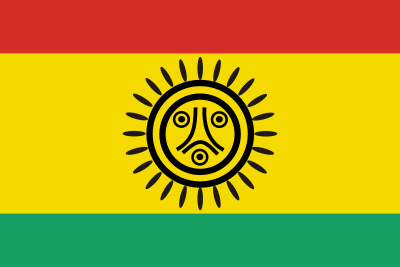- Arawak redirects here
The TaĆno are pre-Columbian indigenous inhabitants of the Bahamas, Greater Antilles, and some of the Lesser Antilles. Their name Taino comes from their encounter with Christopher Columbus. Other Europeans arriving in South America called the same culture of people Arawak from the word for cassava flour, a staple of the race. Their language is a member of the Maipurean linguistic family, which ranges from South America across the Caribbean, and is thought to have been part of the larger, hypothetical group of Arawakan languages that would have spread over an even wider area.
A peaceful people, the Taino had long been on the defensive against their aggressive neighbors, the Caribs, from whom the Caribbean Sea gets its name. Easily dominated by the Spaniards, the Taino population was rapidly decimated by European diseases and overwork by their Spanish overlords who treated them as slaves. While most of their culture was wiped out, Taino survived in Puerto Rico, albeit of mixed lineage, and efforts have been made to revive Taino identity and culture.
Terminology
The indigenous people Christopher Columbus encountered in his first voyage called themselves TaĆno, meaning "good" or "noble," to differentiate themselves from Island-Caribs.[1] Columbus thus called these people the Taino. The name was applied to all the Island TaĆno who in the Lesser Antilles were often labeled according to their specific tribe. Locally, the TaĆno referred to themselves by the name of their location.
Other Europeans arriving in South America called the same culture of people "Arawak" from their word for cassava flour, a staple of the race. From this, the language and the people were eventually called Arawak. It was later realized that the culture and language and indeed the race of peoples known as Arawak and those known as TaĆno were one and the same. Differentiation was made between the Mainland TaĆno or Mainland Arawak living in Guyana and Venezuela, the Island TaĆno or Island Arawak living in the Windward Islands and simply, the TaĆno, living in the Greater Antilles and the Leeward Islands.
Going through time, different writers, travelers, historians, linguists, and anthropologists, have interchangeably used these terms. TaĆno has been used to mean the Greater Antillean tribes only, those plus the Bahamas tribes, those and the Leeward Islands tribes, or all those excluding the Puerto Rican tribes and Leeward tribes. Island TaĆno has been used to refer to those living in the Windward Islands only, those in the northern Caribbean only, or those living in any of the islands. Modern historians, linguists, and anthropologists now hold that the term TaĆno should refer to all the TaĆno/Arawak tribes except for the Caribs. The Caribs are not seen by anthropologists nor historians as being the same people although linguists are still debating whether the Carib language is an Arawakan dialect or creole languageāor perhaps a distinct language, with an Arawakan pidgin often used in communication.
Rouse has classified all inhabitants of the Greater Antilles (except the western tip of Cuba), the Bahamian archipelago, and the northern Lesser Antilles as TaĆno. The TaĆno are subdivided into three main groups: Classic TaĆno, from Hispaniola and Puerto Rico, Western TaĆno or sub-TaĆno, from Jamaica, Cuba (except for the western tip) and the Bahamian archipelago, and Eastern TaĆno, from the Virgin Islands to Montserrat.[1]
The TaĆno of the Bahamas were known as the Lucayan (the Bahamas being known then as the Lucayas), while those in Puerto Rico called themselves Boriquen.[1]
History
Two schools of thought have emerged regarding the origin of the indigenous people of the West Indies. One group contends that the ancestors of the TaĆno came from the center of the Amazon Basin, subsequently moving to the Orinoco valley. From there they reached the West Indies by way of Guyana and Venezuela into Trinidad, proceeding along the Lesser Antilles all the way to Cuba and the Bahamian archipelago. Evidence that supports this theory includes the tracing of the ancestral cultures of these people to the Orinoco Valley and their languages to the Amazon Basin.[1]
The alternate theory, known as the circum-Caribbean theory, contends that the ancestors of the TaĆno diffused from the Colombian Andes. Julian Steward, the theory's originator, suggested a radiation from the Andes to the West Indies and a parallel radiation into Central America and into the Guyanas, Venezuela, and the Amazon Basin.[1]
At the time of Columbus' arrival in 1492, there were five TaĆno kingdoms or territories on Hispaniola, each led by a principal Cacique (chieftain), to whom tribute was paid. At the time of the Spanish conquest, the largest TaĆno population centers may have contained around 3,000 people or more. The TaĆno were historical neighbors and enemies of the Carib, another group with origins in South America who lived principally in the Lesser Antilles. The relationship between the two groups has been the subject of much study.
By the eighteenth century, TaĆno society had been decimated by introduced diseases such as smallpox, and forced assimilation into the plantation economy that Spain imposed in its Caribbean colonies, with its subsequent importation of African slave workers. It is argued that there was substantial mestizaje as well as several Indian pueblos that survived into the nineteenth century in Cuba. The Spaniards who first arrived in the Bahamas, Cuba, and Hispaniola in 1492, and later in Puerto Rico, did not bring women. They might have taken TaĆno wives in civil marriages or otherwise impregnated TaĆno women, which would have resulted in mestizo children.
Europeans and TaĆnos
Columbus and his crew, landing in the Bahamas on October 12, 1492 were the first Europeans to encounter the TaĆno people. A group of Taino people accompanied Columbus on his return voyage back to Europe.[2] The TaĆnos lived on an island which they called Guanahani. After arriving on the island, Columbus renamed it as "San Salvador" (Spanish for "Holy Savior"). It was Columbus who called the TaĆno "Indians," an identification that has grown to encompass all the indigenous peoples of the Western Hemisphere. At this time the neighbors of the TaĆno were the Guanahatabeys in the western tip of Cuba, and the Island-Caribs in the Lesser Antilles from Guadaloupe to Grenada.
Early population estimates of Hispaniola, probably the most populous island inhabited by TaĆnos, range from 100,000 to 1,000,000 people. The maximum estimates for Jamaica and Puerto Rico, the most densely populated islands after Hispaniola, are 600,000 people.[1]
The population had shrunk to 60,000 and by 1531 to 3,000 in Hispanola. In thirty years, between 80 percent and 90 percent of the population died.[3] Many of them were worked to death in the mines and fields, put to death in harsh put-downs of revolts or committed suicide (throwing themselves out of the cliffs or consuming manioc) to escape their cruel new masters. The TaĆno were not immune to European diseases, notably smallpox.[4] Scholars now believe that, among the various contributing factors, epidemic disease was the overwhelming cause of the population decline of the American natives.[5]
On Columbus' second voyage, he began to require tribute from the TaĆno in Hispanola. Each adult over 14 years of age was expected to deliver a certain quantity of gold. In the earlier days of the conquest, if this tribute was not observed, the TaĆno were either mutilated or executed. Later on, fearing a loss of labor forces, they were ordered to bring 25 lb (11 kg) of cotton. This also gave way to a service requirement called encomienda. Under this system, TaĆno were required to work for a Spanish land owner for most of the year, which left little time to tend to their own community affairs.
In 1511, several caciques in Puerto Rico, such as Agueybana, Uroyoan, Guarionex, and Orocobix, allied with the Caribs and tried to oust the Spaniards. The revolt was pacified by the forces of Governor Juan Ponce de LeĆ³n. Hatuey, a TaĆno chieftain who had fled HispaƱola to Cuba with 400 natives in order to unite the Cuban natives, was burned at the stake on February 2, 1512. In HispaƱola, a TaĆno chieftain named Enriquillo mobilized over 3,000 remaining TaĆno in a successful rebellion in the 1530s. These TaĆno were accorded land and a charter from the royal administration. It had little consequence however, as by this time the Indian population was rapidly declining due to European diseases.
Culture
In the center of a typical TaĆno village (yucayeque) was a plaza used for various social activities such as games, festivals, religious rituals, and public ceremonies. These plazas had many shapesāoval, rectangular, or narrow and elongated. Ceremonies where the deeds of the ancestors were celebrated, called areitos, were performed there.[1] The general population lived in large circular buildings (bohio), constructed with wooden poles, woven straw, and palm leaves. These houses would surround the central plaza and could hold 10-15 families. The cacique and his family would live in rectangular buildings (caney) of similar construction, with wooden porches. TaĆno home furnishings included cotton hammocks (hamaca), mats made of palms, wooden chairs (dujo) with woven seats, platforms, and cradles for children.
The TaĆno played a ceremonial ball game called batey. The game was played between opposing teams consisting of 10 to 30 players per team using a solid rubber ball. Normally, the teams were composed of only men, but occasionally women played the game as well.[6] The Classic TaĆnos played in the village's center plaza or on especially designed rectangular ball courts also called batey. Batey is believed to have been used for conflict resolution between communities; the most elaborate ball courts are found in chiefdoms' boundaries.[1] Often, chiefs made wagers on the possible outcome of a game.[6]
TaĆno society was divided into two classes: naborias (commoners) and nitaĆnos (nobles). These were governed by chiefs known as caciques (who were either male or female) which were advised by priests/healers known as bohiques.[7] Bohiques were extolled for their healing powers and ability to speak with gods and as a result, they granted Tainos permission to engage in important tasks.
TaĆnos lived in a matrilineal society. When a male heir was not present the inheritance or succession would go to the eldest child (son or daughter) of the deceasedās sister. TaĆnos practiced a mainly agrarian lifestyle but also fished and hunted. A frequently worn hair style featured bangs in front and longer hair in back. They sometimes wore gold jewelry, paint, and/or shells. TaĆno men sometimes wore short skirts. TaĆno women wore a similar garment (nagua) after marriage. Some TaĆno practiced polygamy. Men, and sometimes women, might have two or three spouses, and the caciques would marry as many as 30.
TaĆnos spoke a Maipurean language. Some of the words used by them such as barbacoa (barbecue), hamaca (hammock), canoa (canoe), tabaco (tobacco), yuca (yucca), and Huracan (hurricane) have been incorporated into the Spanish and English languages.
Food and agriculture
The TaĆno diet centered around vegetables and fruits, meat, and fish. Large animals were absent from the fauna of the West Indies, but small animals such as hutias, earthworms, lizards, turtles, birds, and other mammals were consumed. Manatees were speared and fish were caught in nets, speared, poisoned, trapped in weirs, or caught with hook and line. Wild parrots were decoyed with domesticated birds and iguanas were extracted from trees and other vegetation. TaĆnos stored live animals until they were ready to be consumedāfish and turtles were stored in weirs, and hutias and dogs were stored in corrals.[1]
TaĆno groups in the more developed islands, such as Hispaniola, Puerto Rico, and Jamaica, relied more on agriculture. For important crops they used a sophisticated procedure in which they "heaped up mounds of soil," called conucos, which improved drainage, delayed erosion, and allowed for a longer storage of crops in the ground; for less important crops such as corn they used the more common and rudimentary slash and burn technique. Conucos were 3 feet high and 9 feet in circumference and were arranged in rows. The primary root crop was cassava, a woody shrub cultivated for its edible starchy tuberous root. It was planted using a coa, an early kind of hoe made completely out of wood. Women squeezed cassava to extract its poisonous juice and ground the roots into flour from which they baked bread. Batata (Sweet potato) was the TaĆno's secondary crop; it was consumed as a vegetable.[1]
Contrary to mainland practices, corn was not ground into flour and baked into bread. Instead, it was eaten off the cob. A possible explanation for this is that corn bread becomes moldy faster than cassava bread in the high humidity of the West Indies. TaĆnos grew squash, beans, peppers, peanuts, and pineapples. Tobacco, calabashes (West Indian pumpkins), and cotton were grown around the houses. Other fruits and vegetables, such as palm nuts, guavas, and Zamia roots, were collected from the wild.[1]
Technology
TaĆnos used cotton, hemp, and palm extensively for fishing nets and ropes. Their dugout canoes (Kanoa) were made in various sizes, which could hold from 2 to 150 people. An average sized kanoa would hold about 15 - 20 persons. They used bows and arrows, and sometimes put various poisons on their arrowheads. For warfare, they employed the use of a wooden war club, which they called a macana, that was about one inch thick and was similar to the cocomacaque.
Religion
TaĆno religion centered on the worship of zemĆs or cemĆs. CemĆs were either gods, spirits, or ancestors. There were two supreme gods: YĆŗcahu,[8] which means spirit of cassava, was the god of cassava (the TaĆnos main crop) and the sea and Atabey,[9] mother of YĆŗcahu, was the goddess of fresh waters and fertility. Other minor gods existed in TaĆno religion; some of them related to the growing of cassava while others were related to the process of life, creation and death. Baibrama was a god worshiped for his assistance in growing cassava and curing people from its poisonous juice. Boinayel and his twin brother MĆ”rohu were the gods of rain and fair weather respectively. Popular belief names JuracĆ”n as the god of storms but juracĆ”n was only the word for hurricane in the TaĆno language. Guabancex was the goddess of storms (hurricanes). Guabancex had two assistants: GuataubĆ”, a messenger who created hurricane winds, and Coatrisquie, who created floodwaters.Maquetaurie Guayaba or Maketaori Guayaba was god of Coaybay, the land of the dead. OpiyelguabirĆ”n, a dog-shaped god, watched over the dead. DeminĆ”n Caracaracol, a male cultural hero from which the TaĆno believed to descend, was worshiped as a cemĆ.[1]
CemĆ was also the name of the physical representations of the gods. These representations came in many forms and materials and could be found in a variety of settings. The majority of cemĆs were crafted from wood but stone, bone, shell, pottery, and cotton were also used. CemĆ petroglyphs were carved on rocks in streams, ball courts, and on stalagmites in caves. CemĆ pictographs were found on secular objects such as pottery, and on tattoos. YucahĆŗ, the god of cassava, was represented with a three-pointed cemĆ which could be found in conucos to increase the yield of cassava. Wood and stone cemĆs have been found in caves in Hispaniola and Jamaica.[1]
CemĆs are sometimes represented by toads, turtles, snakes, and various abstract and human-like faces. Some of the carved CemĆs include a small table or tray which is believed to be a receptacle for hallucinogenic snuff called cohoba prepared from the beans of a species of Piptadenia tree. These trays have been found with ornately carved snuff tubes.
Before certain ceremonies, TaĆnos would purify either by inducing vomiting with a swallowing stick or by fasting.[1] After the serving of communal bread, first to the Cemi, then to the cacique, and then to the common people; the village epic would be sung and accompanied by maraca and other instruments.
TaĆno oral tradition explains that the sun and moon come out of caves. Another story tells that people once lived in caves and only came out at night, because it was believed that the Sun would transform them. The TaĆno believed they were descended from the union of DeminaĆ”n Caracaracol and a female turtle. The origin of the oceans is described in the story of a huge flood which occurred when a father murdered his son (who was about to murder the father), and then put his bones into a gourd or calabash. These bones then turned to fish and the gourd broke and all the water of the world came pouring out. TaĆnos believed that the souls of the dead go to Coaybay, the underworld, and there they rest by day, and when night comes they assume the form of bats and eat the fruit "guayaba."
TaĆno heritage in contemporary times
Many people still claim to be descendants of the TaĆno, most notably Puerto Ricans, both on the island and on the United States mainland. People claiming to be TaĆno descendants have been active in trying to assert a call for recognition of their tribe. A recent study conducted in Puerto Rico suggests that over 61 percent of the population possess TaĆno mitochondrial DNA.[10] Recently, a few TaĆno organizations, such as the JatibonicĆ¹ TaĆno Tribal Nation of Boriken (Puerto Rico) (1970), the Taino Nation of the Antilles (1993) and the United Confederation of Taino People (an international initiative) (1998), have been established to put forth these claims. What some refer to as the "TaĆno revival movement" can be seen as an integral part of the wider resurgence in Caribbean indigenous self-identification and organization. The Jatibonicu TaĆno tribe of Boriken, had reaffirmed and reorganized itself in Puerto Rico on November 18, 1970.
Notes
- ā 1.00 1.01 1.02 1.03 1.04 1.05 1.06 1.07 1.08 1.09 1.10 1.11 1.12 1.13 Irving Rouse, The Tainos: Rise and Decline of the People who Greeted Columbus (Yale University Press, 1992, ISBN 0300056966).
- ā John Logan Allen (ed.), North American Exploration: A New World Disclosed Volume: 1 (University of Nebraska Press, 1997, ISBN 0803210159), 13.
- ā "La tragĆ©die des TaĆÆnos," in L'Histoire 322 (July-August 2007): 16
- ā Emory Dean Keoke and Kay M. Porterfield, Encyclopedia of American Indian Contributions to the World: 15,000 Years of Inventions and Innovations (Facts on File, 2001, ISBN 0816040524).
- ā Jared Diamond, Guns, Germs and Steel: The Fates of Human Societies (W.W. Norton, 2005, ISBN 0393061310).
- ā 6.0 6.1 Ricardo AlegrĆa, "The Ball Game Played by the Aborigines of the Antilles." American Antiquity 16(4) (April 1951): 348.
- ā Taino Indian Culture Welcome to Puerto Rico. Retrieved January 20, 2024.
- ā The TaĆnos of Quisqueya (Dominican Republic) called him "YucahĆŗ Bagua MaorocotĆ," which means "White Yuca, great and powerful as the sea and the mountains."
- ā Other names for this goddess include "Guabancex," "Atabei," "Atabeyra," "Atabex," and "Guimazoa."
- ā Juan C. MartĆnez Cruzado, "The Use of Mitochondrial DNA to Discover Pre-Columbian Migrations to the Caribbean:Results for Puerto Rico and Expectations for the Dominican Republic." KACIKE: The Journal of Caribbean Amerindian History and Anthropology (2002).
ReferencesISBN links support NWE through referral fees
- Allen, John Logan (ed.). North American Exploration: A New World Disclosed. Volume 1. University of Nebraska Press, 1997. ISBN 0803210159
- Diamond, Jared. Guns, Germs and Steel: The Fates of Human Societies. W.W. Norton, 2005. ISBN 0393061310
- Forte, Maximilian C. Indigenous Resurgence in the Contemporary Caribbean: Amerindian Survival and Revival. New York: Peter Lang Publishing, 2006. ISBN 0820474886
- Keoke, Emory Dean, and Kay M. Porterfield. Encyclopedia of American Indian Contributions to the World: 15,000 Years of Inventions and Innovations. Facts on File, 2001. ISBN 0816040524
- Rouse, Irving. The Tainos: Rise and Decline of the people who greeted Columbus. Yale University Press, 1992. ISBN 0300056966
- Waldman, Carl. Encyclopedia of Native American Tribes. New York, NY: Checkmark Books, 2006. ISBN 978-0816062744
External links
All links retrieved January 20, 2024.
- The TaĆna Route and Indigenous Culture in Puerto Rico Discover Puerto Rico
- TaĆno - Native Heritage and Identity in the Caribbean Smithsonian: National Museum of the American Indian
- Who Were the TaĆno, the Original Inhabitants of Columbusā Island Colonies? Smithsonian Magazine
- Exploring the Early Americas: Columbus and the TaĆno Library of Congress
Credits
New World Encyclopedia writers and editors rewrote and completed the Wikipedia article in accordance with New World Encyclopedia standards. This article abides by terms of the Creative Commons CC-by-sa 3.0 License (CC-by-sa), which may be used and disseminated with proper attribution. Credit is due under the terms of this license that can reference both the New World Encyclopedia contributors and the selfless volunteer contributors of the Wikimedia Foundation. To cite this article click here for a list of acceptable citing formats.The history of earlier contributions by wikipedians is accessible to researchers here:
The history of this article since it was imported to New World Encyclopedia:
Note: Some restrictions may apply to use of individual images which are separately licensed.
